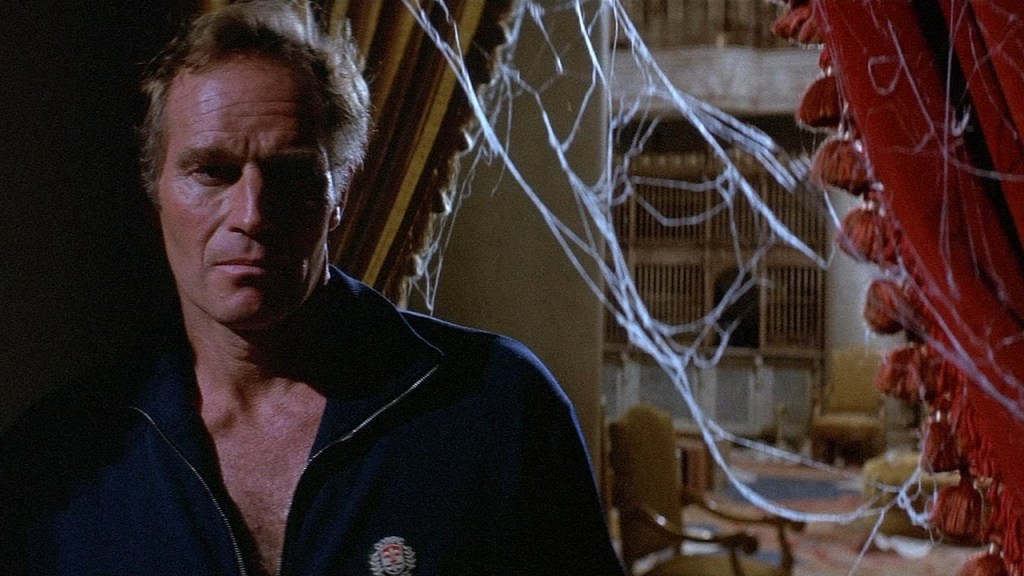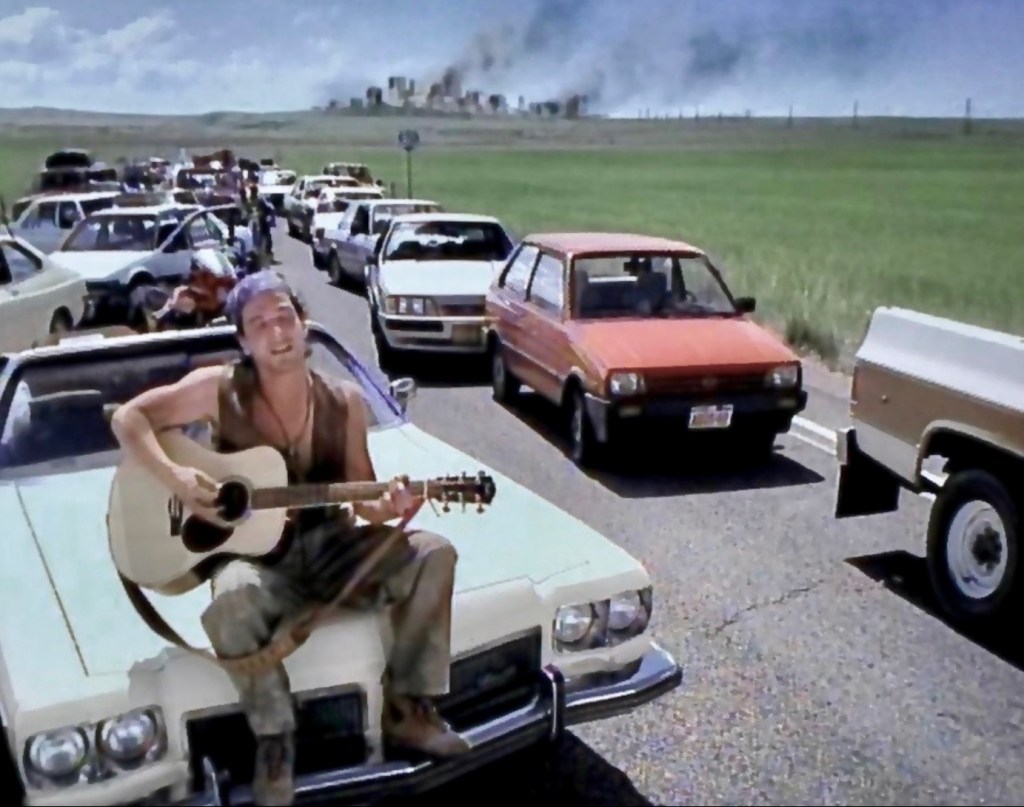Contemporary undead, post-apocalyptic and pandemic tales owe a ton of gratitude to Richard Matheson’s I AM LEGEND.

Matheson, whose onscreen work includes THE INCREDIBLE SHRINKING MAN, Steven Spielberg’s DUEL, Roger Corman adaptations of such Edgar Allen Poe classics as HOUSE OF USHER, THE PIT AND THE PENDULUM and THE RAVEN, plus legendary episodes of THE TWILIGHT ZONE, has been called “one of the most important writers of the twentieth century” by Ray Bradbury, and he wasn’t kidding.
Published in 1954 to mixed reviews, Matheson’s I AM LEGEND has graduated to become one of the most influential Sci-Fi novels ever written, with today’s zombie, vampire, and post-apocalyptic genre tales — from NIGHT OF THE LIVING DEAD and THE STAND to 28 DAYS LATER, WORLD WAR Z, and THE WALKING DEAD — drawing directly and indirectly from Matheson’s brainchild.
The dystopian I AM LEGEND follows Robert Neville, the apparent last man on Earth due to his immunity to a global pandemic that has transformed humanity into hordes of bloodthirsty vampires. Scavenging for food and supplies by day and barricading himself in at night from the deadly fiends, he desperately seeks out other survivors while trying to determine the cause of the plague — and maybe even find a cure.
A former family man, Neville’s daughter was claimed by the disease, and he was forced to kill his wife after she was infected and rose again as a vampire. Now, after years of lonely existence, devoid of human contact, this shell of a man has become a depressed alcoholic. He’s losing his mind. His outlook brightens upon discovering the companionship of a dog, only to be subsequently devastated when the pooch succumbs to the infection.
Then Ruth comes along: an almost impossible human appearing to Neville after years of solitude. The day walker’s explanations for her survival and behavior raise his suspicions, but defy any established logic that she could be a vampire. But soon, Ruth is revealed to be a spy for the nocturnal creatures, and Neville learns that they are a much more intelligent race than he could have ever imagined, evolving into a new species that can withstand the daylight with the aid of medicine — and who are attempting to rebuild society.

With the last remaining human — Neville — marauding and killing large numbers of vampires on a daily basis, who is the true monster now?
Incorporating traditional notions of vampire lore such as wooden stakes, garlic, crucifixes, mirror reflections, and deadly sunlight, I AM LEGEND also rethinks and expands on preconceived ideas of vampirism while tackling the theme of man’s growing isolation amid the post-war boom of the ’50s, flavored with a generous helping of religion, God’s wrath, and a topical Red Scare analogy.
Matheson takes the idea of the lone wolf protagonist and turns it on its head, illuminating the fine line between hero and villain: it’s all a matter of perspective, and Neville is no hero—he’s actually an egocentric monster who spends his days indiscriminately wiping out large swaths of a developing species. Rather than the vampires being monsters of legend, events have come “full circle,” and Neville himself is the stuff of legends, the bogeyman, “a new superstition” to the evolution of humanity.
THE MOVIE ADAPTATIONS

THE LAST MAN ON EARTH (1964)
Horror staple Vincent Price headlines this low-budget Italian production with a script written by Matheson (who later dropped his name from the credits, choosing his pen name Logan Swanson instead after it was rewritten by other writers). Renamed Dr. Robert Morgan, Price’s character holes up in the ’burbs by night and kills weak, unintelligent vampires by day following a worldwide bacterial plague. Immune due to a vampire bat bite years earlier, Morgan also confronts Ruth the spy, then ironically meets a cruel demise in the same way that he dispatches of the vampire “freaks” surrounding him. Although the film has become a bit of a cult favorite, Matheson said publicly that he didn’t care for it and, although a fan of Price, felt that the actor was miscast.

THE OMEGA MAN (1971)
Sporting an array of comfy track suits and a clenched jaw, Charlton Heston is the last man on Earth, battling hordes of nocturnal albino mutants—dubbed “The Family”— transformed by biological warfare. THE OMEGA MAN turned Matheson’s premise into a topical tale, tackling many of the major themes of the 1960s, from religious cults, Woodstock, and the counter- culture movement to race relations with a touch of blaxploitation, largely influenced by the Manson Family murders and Helter Skelter. Great Sci-Fi holds a mirror up to current events while being veiled by the genre, much like STAR TREK did on television in the ’60s, and 1971’s OMEGA MAN does just this—albeit it is thinly veiled, at best. Matheson was more forgiving on this cinematic take on his novel, since it was so far removed from his original story.

I AM LEGEND (2007)
After years of languishing in development hell (with Arnold Schwarzenegger originally championing the project at one point with Ridley Scott attached to direct), I AM LEGEND stars Will Smith trying to do justice to Matheson’s work. Moving the action to a New York City overrun by vegetation and wildlife, the setting is believable and the set-pieces genuinely cool and frightening, but the film ultimately fails on a variety of levels, no thanks in part to unconvincing, overly CGI’d vampire hordes and a bleak, reworked ending—the original final moments found Smith’s Neville facing the vampires as they break into his stronghold to rescue one of their own, mirroring the burgeoning humanity of the adversaries in the book. But the ending did not test well with audiences, and was changed to have Neville sacrifice himself in a literal blaze of glory, diluting the tale’s ultimate message.

I AM OMEGA (2007)
A knockoff production designed to capitalize on the big-budget Will Smith adaptation, I AM OMEGA was a straight-to-video release from the indie studio The Asylum with Mark Dacascos, named Renchard, battling hordes of cannibalistic, zombie-like creatures in a post-apocalyptic Los Angeles setting. An unofficial adaptation of Matheson’s work, the title dodges direct comparison by obviously combining THE OMEGA MAN with I AM LEGEND. (See how they did that?) For those not in the know, The Asylum regularly commits cinematic crimes against poor, unassuming video consumers, churning out “mockbusters” to cash in on Hollywood’s blockbusters, with titles including TRANSMORPHERS, SNAKES ON A TRAIN, THE DAY THE EARTH STOPPED, and AGE OF THE HOBBITS, several of which have earned legal action from major studios.
THE IMPACT AND LEGACY OF ‘LEGEND‘
I AM LEGEND was really the first Sci-Fi tale to incorporate mutant hordes with a post-apocalyptic scenario. More than half a century later, an endless list of major and minor movies, TV shows, and novels owe many of their plots and premise to the influence of Matheson’s story. Here are a handful that have become classics in their own right, but that you may not have considered to be derivative of Matheson’s material in one way or another—until now.

NIGHT OF THE LIVING DEAD
The director of this grandfather of the zombie film genre, George A. Romero, directly credits Matheson’s work as the inspiration for his shuffling undead masterwork, with his subsequent entries incorporating even more of Matheson’s ideas—from survivors holing up in the vacant shopping mall landscape of DAWN OF THE DEAD to the twisted scientific experiments in the underground bunker of DAY OF THE DEAD.

28 DAYS LATER
With our protagonist waking up in a hospital to find the streets of London completely deserted, only to discover that the UK, if not the whole world, has been decimated by a rage virus—with hordes of infected roaming and running for the jugular—Danny Boyle’s zombie game-changer still owes aplenty to Matheson’s original tale.

THE WALKING DEAD
While the zombie pandemic has become a genre unto itself, elements of THE WALKING DEAD perfectly embody the horrific situations Neville faces in LEGEND, from an inexplicable disease transforming the population into the undead to principal characters forced to kill their loved ones after they’ve been afflicted.

STEPHEN KING’S THE STAND & MORE
Stephen King has credited Matheson as a huge influence on his own work, even dedicating his apocalyptic tech thriller CELL to the late author. King’s stories that draw on Matheson’s writing include the vampire tale SALEM’S LOT (including that memorably creepy scene in which a vampirized Danny Glick scrapes at Mark’s window) and THE STAND, which follows the remaining denizens of a post-apocalyptic landscape after a devastating bioweapon flu nicknamed “Captain Trips” wipes out the majority of the world’s population.
This article, written by David Weiner, was originally published in Famous Monsters magazine issue #272.
###
You made it to the end of the piece. Sweet. Now, please take a moment to “like” IT CAME FROM… on Facebook and “follow” on Instagram and on Twitter and/or Tumblr for more great retro content.
Then, check out more of my celebrity and filmmaker interviews HERE.
______________________________________________________________________________
YOU CAN HELP IT CAME FROM BLOG “KEEP THE LIGHTS ON” WITH BUY ME A COFFEE. Thanks!

